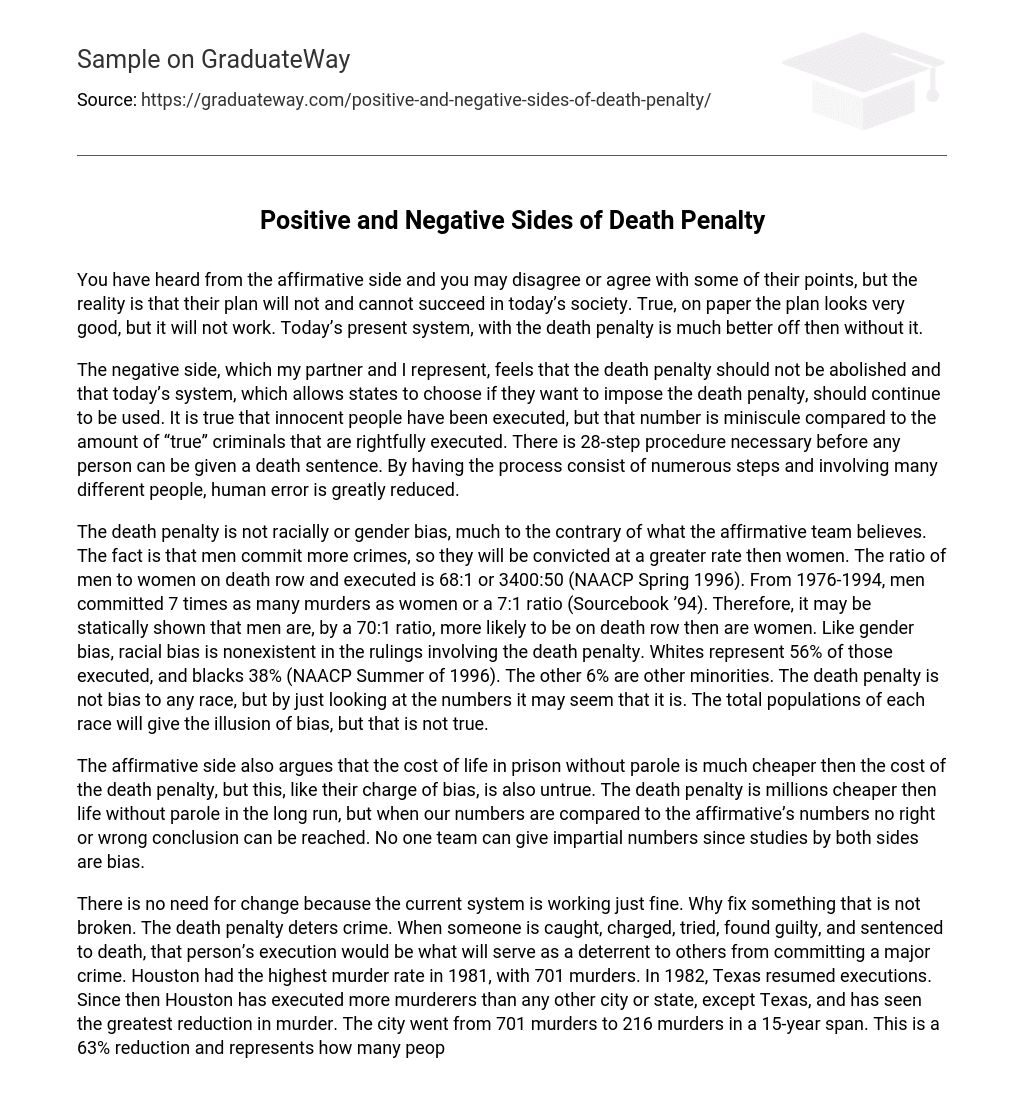Although there may be differing opinions on certain arguments put forth by the affirmative side, it is important to acknowledge that their plan will not succeed in today’s society. Despite its attractive presentation on paper, it is destined for failure. Our existing system, which incorporates the death penalty, is significantly better than an alternative approach.
In favor of maintaining the death penalty and allowing states to enforce it, my partner and I argue that although there have been instances where innocent individuals were mistakenly executed, their occurrence is relatively low compared to the larger population of “true” criminals deserving capital punishment. The process for imposing a death sentence involves a comprehensive 28-step procedure that includes input from multiple individuals, effectively minimizing human error.
The evidence contradicts the affirmative team’s belief that the death penalty is biased against specific races or genders. Men have a higher conviction rate than women due to their higher crime rates. According to NAACP Spring 1996, the ratio of men to women on death row and executed is 68:1 or 3400:50. Sourcebook ’94 states that from 1976-1994, men committed seven times as many murders as women, resulting in a ratio of 7:1. Hence, statistically speaking, men are significantly more likely to be on death row compared to women by a ratio of 70:1.
Regarding racial bias in death penalty rulings, NAACP Summer of 1996 data shows that there is none. Whites make up 56% of those executed while blacks represent 38%. The remaining 6% include other minority groups. These numbers may imply bias when considering the total populations of each race but it is not true.
Both sides in the debate make false claims. The affirmative side asserts that life in prison without parole is cheaper than the death penalty, but this is not true. Conversely, the cost comparison between the two punishments cannot be determined definitively because both sides offer biased studies. While the death penalty may ultimately be millions cheaper, an unbiased conclusion cannot be reached without impartial data from both teams.
The current system is operating effectively and does not necessitate any alterations. There is no need to fix something that is not broken. The death penalty acts as a deterrent to crime, as when an individual is apprehended, charged, tried, convicted, and given a death sentence, their execution serves as a deterrent to others considering committing serious crimes.
In 1981, Houston had the highest murder rate with 701 murders; however, executions were reinstated in Texas in 1982. Since then, Houston has executed more murderers than any other city or state (except Texas) and has experienced the most significant decrease in murders. Over a span of 15 years, the number of murders in the city decreased from 701 to 216 – representing a reduction of 63%. This reduction highlights how many individuals were saved by the death penalty – potential victims whose lives were spared.
Despite assertions that the death penalty does not work, a econometric study conducted in 1994 demonstrated that each execution deters at least eight additional murders. The goal of the death penalty is not seeking revenge against criminals but preventing similar crimes from occurring. Therefore, execution acts as a deterrent ultimately leading to prevention.
Despite facing a life sentence with no chance of parole, a murderer can still have another opportunity to commit murder. This can happen whether they kill again inside the prison or manage to escape and commit murder outside. However, they will eventually be imprisoned again and given yet another chance to take someone’s life. If the death penalty had been imposed, this individual would not have had the chance for a second offense. Therefore, implementing capital punishment acts as a deterrent.
The death penalty is not considered cruel and unusual because most states use lethal injection, which is not deemed cruel. Despite there being rare incidents of failed executions and the execution of innocent individuals, we must also take into account the perspective of the victim who suffered and lost their life. Would it not be cruel to label the death penalty as cruel and unusual while disregarding the cruelty inflicted upon the victim? The victim was senselessly murdered while the murderer would be executed without reason. If someone chooses to break the law, they should accept facing its consequences in the future. Allowing individuals to violate our nation’s laws without equivalent consequences insults society and the victim. Not implementing the death penalty diminishes the value of the victim’s life according to our affirmative team’s viewpoint.
The death penalty requires some slight improvements such as achieving greater consistency and reducing the number of appeals permitted. By reducing appeals, the process will become more cost-effective and time-efficient. With these two modifications, along with a few other minor adjustments while maintaining reliance on the current system, the death penalty will be fully utilized.
The affirmative team proposes a plan that will result in increased spending. This involves constructing more prisons to accommodate the expected increase in population caused by abolishing the death penalty. Additionally, extra security measures will be necessary to maintain order among the larger population. The problem of overpopulation requires a greater emphasis on rehabilitation, which means more space and counselors are needed, resulting in additional costs. Unfortunately, this means that prisoners who can truly be reformed will not receive enough attention due to the focus on a larger rehabilitating population. Critically, the affirmative team’s plan has deficiencies and is impractical. In contrast, the negative team presents a proven plan with few drawbacks and many advantages, demonstrating its effectiveness in achieving the task at hand.





